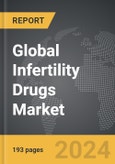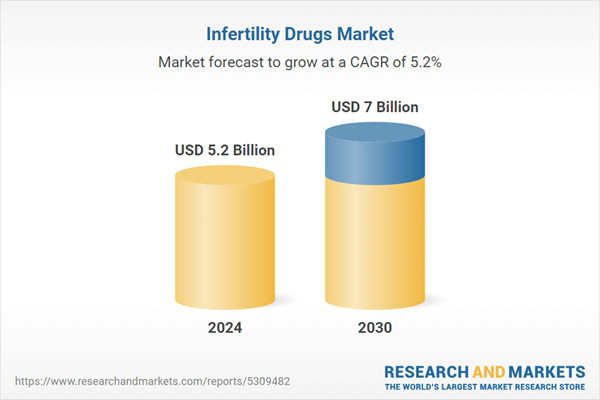The global market for Infertility Drugs was valued at US$5.2 Billion in 2024 and is projected to reach US$7.0 Billion by 2030, growing at a CAGR of 5.2% from 2024 to 2030. This comprehensive report provides an in-depth analysis of market trends, drivers, and forecasts, helping you make informed business decisions. The report includes the most recent global tariff developments and how they impact the Infertility Drugs market.
Segments: Product (Hormone-Based Therapy, Other Products).
Geographic Regions/Countries: World; United States; Canada; Japan; China; Europe (France; Germany; Italy; United Kingdom; Spain; Russia; and Rest of Europe); Asia-Pacific (Australia; India; South Korea; and Rest of Asia-Pacific); Latin America (Argentina; Brazil; Mexico; and Rest of Latin America); Middle East (Iran; Israel; Saudi Arabia; United Arab Emirates; and Rest of Middle East); and Africa.
The analysts continuously track trade developments worldwide, drawing insights from leading global economists and over 200 industry and policy institutions, including think tanks, trade organizations, and national economic advisory bodies. This intelligence is integrated into forecasting models to provide timely, data-driven analysis of emerging risks and opportunities.
Global Infertility Drugs Market - Key Trends & Drivers Summarized
What Are Infertility Drugs and How Do They Support Reproductive Health?
Infertility drugs are medications used to treat reproductive problems in both men and women to increase their chances of conceiving. These drugs generally work by regulating or stimulating ovulation, enhancing sperm production, or correcting hormonal imbalances. In women, common treatments include drugs like Clomiphene citrate, Gonadotropins, and Metformin, which are used to trigger the release of eggs from the ovaries. For men, medications may improve sperm count and quality. The development and use of these drugs are critical as infertility rates have been rising globally, driven by factors such as delayed childbearing, lifestyle changes, and increased prevalence of conditions like polycystic ovary syndrome (PCOS) and endometriosis.How Are Advances in Medical Research Shaping the Infertility Drugs Market?
The infertility drugs market is continuously shaped by advances in medical research and biotechnology, including the development of more targeted hormone treatments and the introduction of new drug classes. Innovations such as the use of artificial intelligence (AI) to personalize drug protocols based on individual patient responses are enhancing the efficacy and success rates of these treatments. Furthermore, ongoing research into the genetic factors underlying infertility is opening up possibilities for genomic therapies that could correct genetic defects causing reproductive issues. Such advancements not only promise to increase the effectiveness of existing drugs but also help in developing novel therapies with fewer side effects.What Trends Are Influencing the Demand for Infertility Drugs?
Several trends are currently influencing the demand for infertility drugs. Social trends, including the increasing age of first-time parents, contribute significantly to rising infertility rates, thereby driving the need for effective pharmacological interventions. The growing public awareness and acceptance of fertility treatments, coupled with improvements in healthcare infrastructure, are making these drugs more accessible to a broader population. Moreover, health insurance providers are gradually recognizing the need for comprehensive reproductive health services, including coverage for infertility treatments, which is making these drugs more affordable and further stimulating market growth.Growth in the Infertility Drugs Market Is Driven by Several Factors
The growth in the infertility drugs market is driven by several factors related to advancements in medical science, changes in socio-economic conditions, and evolving consumer behaviors. Technological progress in drug development and the application of precision medicine are significantly enhancing the effectiveness and reducing the risks associated with infertility treatments. Economic factors, such as increased healthcare spending and the inclusion of fertility treatments in insurance coverage, are making these drugs more accessible and affordable. Additionally, global changes in attitudes towards fertility and an increase in the number of fertility clinics are expanding the consumer base for these drugs. Together, these dynamics are propelling robust growth in the infertility drugs market, reflecting a combination of improved treatment options and broader societal acceptance of fertility issues.Report Scope
The report analyzes the Infertility Drugs market, presented in terms of units. The analysis covers the key segments and geographic regions outlined below.Segments: Product (Hormone-Based Therapy, Other Products).
Geographic Regions/Countries: World; United States; Canada; Japan; China; Europe (France; Germany; Italy; United Kingdom; Spain; Russia; and Rest of Europe); Asia-Pacific (Australia; India; South Korea; and Rest of Asia-Pacific); Latin America (Argentina; Brazil; Mexico; and Rest of Latin America); Middle East (Iran; Israel; Saudi Arabia; United Arab Emirates; and Rest of Middle East); and Africa.
Key Insights:
- Market Growth: Understand the significant growth trajectory of the Hormone-Based Therapy segment, which is expected to reach US$5.3 Billion by 2030 with a CAGR of a 5.6%. The Other Products segment is also set to grow at 4.2% CAGR over the analysis period.
- Regional Analysis: Gain insights into the U.S. market, valued at $1.3 Billion in 2024, and China, forecasted to grow at an impressive 8.1% CAGR to reach $1.6 Billion by 2030. Discover growth trends in other key regions, including Japan, Canada, Germany, and the Asia-Pacific.
Why You Should Buy This Report:
- Detailed Market Analysis: Access a thorough analysis of the Global Infertility Drugs Market, covering all major geographic regions and market segments.
- Competitive Insights: Get an overview of the competitive landscape, including the market presence of major players across different geographies.
- Future Trends and Drivers: Understand the key trends and drivers shaping the future of the Global Infertility Drugs Market.
- Actionable Insights: Benefit from actionable insights that can help you identify new revenue opportunities and make strategic business decisions.
Key Questions Answered:
- How is the Global Infertility Drugs Market expected to evolve by 2030?
- What are the main drivers and restraints affecting the market?
- Which market segments will grow the most over the forecast period?
- How will market shares for different regions and segments change by 2030?
- Who are the leading players in the market, and what are their prospects?
Report Features:
- Comprehensive Market Data: Independent analysis of annual sales and market forecasts in US$ Million from 2024 to 2030.
- In-Depth Regional Analysis: Detailed insights into key markets, including the U.S., China, Japan, Canada, Europe, Asia-Pacific, Latin America, Middle East, and Africa.
- Company Profiles: Coverage of players such as Abbott Laboratories, AbbVie Inc., Allergan Plc, Bayer AG, Eli Lilly and more.
- Complimentary Updates: Receive free report updates for one year to keep you informed of the latest market developments.
Some of the 44 companies featured in this Infertility Drugs market report include:
- Abbott Laboratories
- AbbVie Inc.
- Allergan Plc
- Bayer AG
- Eli Lilly
- F. Hoffmann-La Roche Ltd
- Ferring Pharmaceuticals AS
- GlaxoSmithKline Plc
- LIVZON Pharmaceutical Group Inc.
- Merck & Co. Inc.
- Merck KGaA
- Novartis AG
- Pfizer Inc.
- Sanofi
- Takeda Pharmaceutical Company Limited
- Zydus Pharmaceuticals
Tariff Impact Analysis: Key Insights for 2025
Global tariff negotiations across 180+ countries are reshaping supply chains, costs, and competitiveness. This report reflects the latest developments as of April 2025 and incorporates forward-looking insights into the market outlook.The analysts continuously track trade developments worldwide, drawing insights from leading global economists and over 200 industry and policy institutions, including think tanks, trade organizations, and national economic advisory bodies. This intelligence is integrated into forecasting models to provide timely, data-driven analysis of emerging risks and opportunities.
What’s Included in This Edition:
- Tariff-adjusted market forecasts by region and segment
- Analysis of cost and supply chain implications by sourcing and trade exposure
- Strategic insights into geographic shifts
Buyers receive a free July 2025 update with:
- Finalized tariff impacts and new trade agreement effects
- Updated projections reflecting global sourcing and cost shifts
- Expanded country-specific coverage across the industry
Table of Contents
I. METHODOLOGYII. EXECUTIVE SUMMARY2. FOCUS ON SELECT PLAYERSIII. MARKET ANALYSISIV. COMPETITION
1. MARKET OVERVIEW
3. MARKET TRENDS & DRIVERS
4. GLOBAL MARKET PERSPECTIVE
UNITED STATES
CANADA
JAPAN
CHINA
EUROPE
FRANCE
GERMANY
ITALY
UNITED KINGDOM
SPAIN
RUSSIA
REST OF EUROPE
ASIA-PACIFIC
AUSTRALIA
INDIA
SOUTH KOREA
REST OF ASIA-PACIFIC
LATIN AMERICA
ARGENTINA
BRAZIL
MEXICO
REST OF LATIN AMERICA
MIDDLE EAST
IRAN
ISRAEL
SAUDI ARABIA
UNITED ARAB EMIRATES
REST OF MIDDLE EAST
AFRICA
Companies Mentioned (Partial List)
A selection of companies mentioned in this report includes, but is not limited to:
- Abbott Laboratories
- AbbVie Inc.
- Allergan Plc
- Bayer AG
- Eli Lilly
- F. Hoffmann-La Roche Ltd
- Ferring Pharmaceuticals AS
- GlaxoSmithKline Plc
- LIVZON Pharmaceutical Group Inc.
- Merck & Co. Inc.
- Merck KGaA
- Novartis AG
- Pfizer Inc.
- Sanofi
- Takeda Pharmaceutical Company Limited
- Zydus Pharmaceuticals
Table Information
| Report Attribute | Details |
|---|---|
| No. of Pages | 193 |
| Published | April 2025 |
| Forecast Period | 2024 - 2030 |
| Estimated Market Value ( USD | $ 5.2 Billion |
| Forecasted Market Value ( USD | $ 7 Billion |
| Compound Annual Growth Rate | 5.2% |
| Regions Covered | Global |









